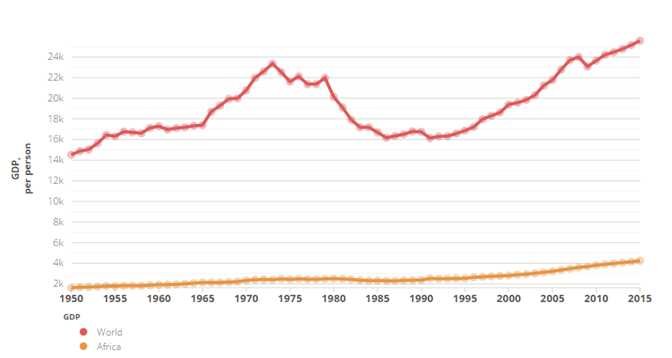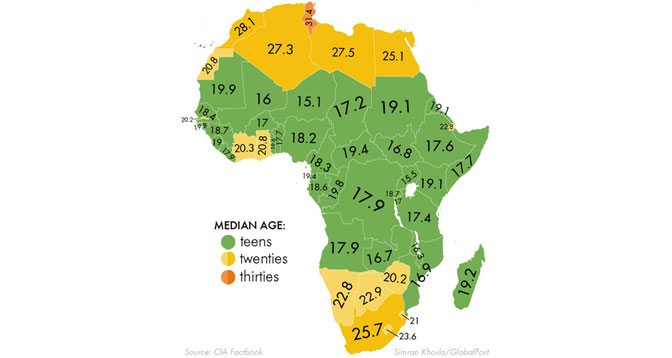- Stay Connected
Disruptive innovation: The most viable strategy for economic development in Africa
Without question, Africa is the poorest region in the world. The chart below shows the growth of gross domestic product (GDP) per person – an imperfect but widely used measure – for Africa and the rest of the world. Not only is the rest of the world six times richer than Africa, GDP per person has grown at a faster rate. These numbers are significant because they do not simply represent the macro-economic realities that governments in African countries must manage; they also translate to the circumstances in which millions of people live their lives. The numbers translate to the additional 50 million people in Africa living in extreme poverty today than did in 1990. They translate to the millions of babies, children, and mothers that die annually because they cannot afford life-saving medication. They translate to skyrocketing unemployment which reduces the barriers to youth involvement in terroristic activities. The numbers are very significant.

But perhaps of even more significance is the demographic transformation that Africa is experiencing, and will continue to experience over the next several decades. Now home to 1.1 billion people, by 2050 the United Nations estimates that Africa’s population will reach 1.8 billion; by 2100, 2.3 billion people, a majority of whom will be youth.

Disruptive Innovations Targeted at Non-Consumption
Through the course of my research with Harvard Business School Professor, Clayton Christensen, we have learned that no country has developed in a sustainably without investments in disruptive innovations. There are two types of disruptive innovations, low-end disruptive innovation and new-market disruptive innovation. I write about the new-market disruptive innovations, which are targeted at non-consumption, a circumstance where a majority of people in a society are unable to afford a particular product due to cost, time, or skill constraints. These innovations transform the existing complicated and expensive products to simple to use, more affordable products, thereby making them more accessible to a larger set of people in society, such as M-PESA, the mobile money platform in Kenya. They serve as the engine of economic development in a society.
Can Africa Spur Disruptive Innovations
It is tempting to discount the possibility of executing disruptive innovations in Africa because of the many obstacles to innovation on the continent, including poor infrastructure, the difficulty of doing business, and the very low incomes on the continent. But when these obstacles are framed as opportunities, innovators can build truly disruptive companies.
In fact, it is precisely because these obstacles exist that disruptive innovations can thrive in Africa.
Nollywood and Noodles
Nollywood, Nigeria’s film industry, has taken many in the world by storm. While Hollywood’s revenues dwarf Nollywood, it is difficult to overlook Nollywood’s impact in Nigeria. The industry, according to a UN report, is now worth approximately $5 billion, employs more than one million people, and generates around $800 million annually. Nollywood has been able to thrive precisely because it is a disruptive innovation targeted at the average Nigerian citizen unable to purchase, watch, and perhaps relate to Hollywood movies. The innovators in Nollywood have keyed into the vast non-consumption of movies in Nigeria, and Africa, and have created relevant and relatable movies that have given birth to a booming industry.
When Haresh Aswani decided to start importing Indomie Noodles into Nigeria in 1988, the decks were stacked against his company, Tolaram. Nigeria was ruled by a military government, GDP per capita was only $256, and 78% of people lived on less than $2 per day. But Aswani began importing noodles into Nigeria and since then, has built 11 factories that manufacture many of the inputs for the noodles. The company directly employs approximately 10,000 people and hundreds of thousands indirectly. A packet of Indomie Noodles costs roughly 18 cents, a product affordable by the majority of Nigerians. Tolaram has begun expansion plans into other African countries. Where many see obstacles, the company sees opportunity.
The Rebirth of an Old Idea
Investing in disruptive innovations is not a new strategy for creating prosperity. The United States, many European countries, the Four Asian Tigers, and many other rich countries followed this strategy with great success. The returns from their investments were then invested in infrastructure, education, healthcare, and in building institutions. It is tempting to spend billions of dollars on infrastructure, institution building, education, healthcare, and other development indicators that are correlated with prosperity. But a closer look at rich countries today shows that investments in disruptive innovations came first. Africa should thus follow suit.
Governments should support entrepreneurs whose business models are targeted at non-consumption. By doing this, they will inevitably create jobs for many people, as was the case with Nollywood and Indomie Noodles. This, our research suggests, will ultimately lead to unfettered prosperity in Africa.Source :world Bank
